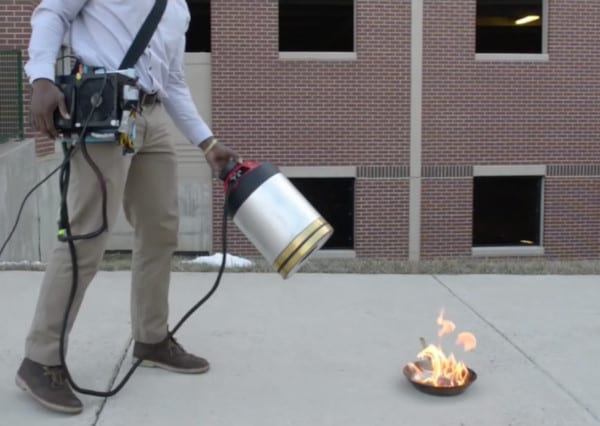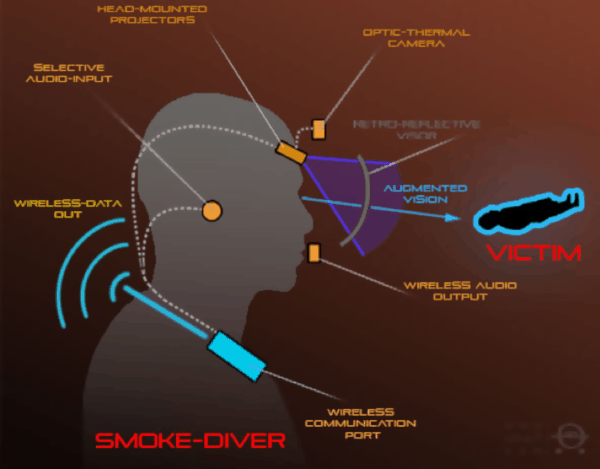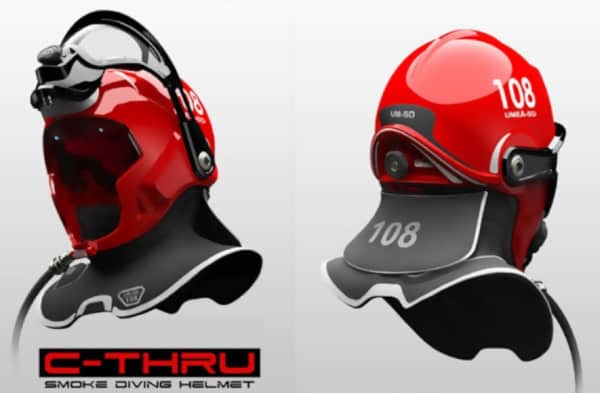New tech is changing firefighting and fire detection
Technological advances in fire protection abound—and fire safety technology now includes futuristic firefighting helmets, fire extinguishers that put out flames with sound, smart home fire and smoke detectors, a water mist “gun,” and a modern take on a very old piece of tech: the firefighting grenade.
In this article, we explain the capabilities of these items and explore how they are being designed for or actually used in different settings. Also, be sure to check out our previous look at modern fire safety technology.
PyroLance aims to protect firefighters from dangerous conditions
The PyroLance is a high-pressure water gun that uses water mist fire suppression technology. It is designed to allow firefighters to attack fires from outside of a structure, reducing their exposure to heat, toxic smoke, and dangerous flashovers.
The water gun’s creation was spurred by the crash of a B-2 stealth bomber in 2008 that proved difficult to extinguish: “‘The firefighters had difficulty getting through the composite layers of the aircraft skin to fight the fire,’ U.S. Air Force Chief Master Sgt. Scott Knupp told CNNMoney.”
The PyroLance uses a mixture of pressurized water and granite dust to cut through materials such as brick, concrete, steel, and bullet-resistant glass in 30 to 35 seconds, creating a small hole. It then forces a fine water mist into the structure through the hole. As with water mist fire sprinkler systems, the mist introduced by the PyroLance works quickly, “lowering the temperature from around 1,500 F to 200 F in less than a minute.” In addition to working on hard-to-reach fires, it makes it safer for firefighters to enter a structure with traditional hoses.
This short video demonstrates how PyroLance works:
PyroLance can be used with standard fire engines and it’s employed by both U.S. Air Force and Navy firefighters to combat fires in difficult spaces, such as those involving aircraft crashes and fires aboard Navy vessels.
A sonic fire extinguisher joins the ranks of new fire safety technology
In 2017, two engineering students from George Mason University in Virginia developed a mobile, hand-held sonic fire extinguisher. The device, consisting of an amplifier and a cardboard collimator used to focus the sound, employs low frequency, bass sound waves to separate burning material from its oxygen supply, thus snuffing out the fire.
Although this concept isn’t new, Seth Robertson and Viet Tran are the first to utilize it in a device that can reliably extinguish fires. Because it employs neither water nor chemicals, Roberton and Tran’s extinguisher is significantly cleaner to deploy than traditional methods.

The sonic fire extinguisher prototype is only effective against small fires, but Roberton and Tran are in the process of developing the technology for larger-scale use, such as fighting forest fires and conflagrations in crowded urban environments. One possible application would be to attach the devices to drones and deploy a large group of them to an affected area.
Fire extinguishing grenades undergo a complete transformation
In the late 1800s and early 1900s, “fire grenades” were commonly used to help extinguish small residential fires. These grenades were sealed glass orbs filled with either saltwater or carbon tetrachloride. If a fire broke out, the grenade was tossed onto the fire, where it shattered and released its liquid, which then vaporized and hopefully extinguished the flames.

These devices were sometimes ineffective, especially for more developed fires. And in 1954, NFPA pronounced them unacceptable for use. Aside from not being consistently effective, the broken glass was dangerous and it was found that “the carbon tetrachloride decomposed at high temperatures producing a toxic gas, Phosgene.”
Modern fire grenades, however, utilize condensed aerosol fire suppression to extinguish fires. These small devices can be thrown towards a fire from a distance, allowing the user to disperse the extinguishing agent while remaining far from the heat and the flames.
Once deployed, the grenade will dispense an extinguishing agent throughout the area. This agent is typically an aerosol created by the thermal decomposition of a solid potassium compound. The aerosol mist interferes with the fire’s free radicals and disrupts its combustion cycle. Even if the fire is not fully extinguished, the aerosol mist cloud can suppress the fire enough to allow firefighters to approach the area with a greater degree of safety.
These modern fire grenades work best in enclosed spaces. Aside from the benefits engendered by being able to use them from a distance, this fire safety technology also may require less maintenance and user training than conventional handheld fire extinguishers.

Swedish inventors design a new future for firefighting
A Swedish graduate student integrated several different technologies into a single, futuristic helmet called the C-Thru back in 2013. Similar to a fighter pilot’s helmet, it featured a lens on which it projected critical information—CO2 levels, remaining oxygen, temperature, and other data. Firefighters could also maintain visibility in thick smoke by using an optional thermal imaging camera.
The current version of the C-Thru helmet takes advantage of recent advances in augmented reality (AR), visual neuroscience, and cloud computing. The optic-thermal camera picks up thermal data which is sent to a wireless device held by a leader of a smoke diver brigade who is positioned outside of the hot zone. The device accesses the cloud and data are calculated and sent back to the helmet. The retro-reflective visor in the helmet then displays wireframe data—outlines of objects in the space—in a single color that is chosen by the user.
While the firefighter searches around, the information is simultaneously overlaid and match-moved, “a technique that allows the insertion of computer graphics into live-action footage with correct position, scale, orientation, and motion relative to the photographed objects in the shot.” This technology enables a firefighter to view all aspects of the mission area at once.
While it’s not commercially available as of this writing, the C-Thru helmet is currently being developed by Qwake Technologies—and the company claims that it allows firefighters to get in and out of a fire five times faster. Learn more about the C-Thru helmet here and watch this four-minute performance test:
Smart smoke and heat detectors offer extra protection in homes
Smoke detectors save lives—57% of home fire fatalities occur in residences with no working smoke alarms. But traditional residential detectors have limitations:
- They only sound and/or light up a local audible alarm; so, if no one is home, no one will quickly address a fire.
- Most only detect the presence of smoke particles through ionization detectors, photoelectric detectors, or a combination of both.
- Residents often remove batteries or disable smoke alarms to stop annoying low-battery chirps or nuisance alarms after cooking and forget to replace/fix them.
A newer form of fire safety technology addresses these issues and is gaining more widespread use in modern homes: smart smoke and heat sensors that are linked to smart home automation systems. These devices typically rely on a combination of detection technologies that broaden their ability to sense fires: traditional particle smoke-detection sensors, fixed-temperature sensors, and “rate-of-rise” sensors that trigger an alert if they sense a rapid increase in room temperature.
Smart smoke and heat sensors can also be networked to a smart home to provide a capability that’s similar to commercial addressable and monitored fire alarm systems. In addition to sounding a local alarm, sensors can send a message to a home automation control panel that pinpoints the area of the fire and alerts a resident if they are not home; and if the sensors are used as part of a monitored home security system, a monitoring service will receive an alert and call the fire department if the homeowner is unavailable or confirms an emergency.
Finally, many of these detectors have very long battery lives (up to about 10 years) and send mobile alerts to homeowners when the battery is running low, getting rid of the annoying chirps that cause people to remove batteries or otherwise disable the devices.
New fire safety technology aims to save lives and property
Emerging fire protection technology continues to be designed, adopted, and improved upon, and each advance has the potential to save lives and property. Some equipment may reduce the risk to firefighting professionals. Other devices, like the smart smoke and heat sensor, offer broader protection to homeowners using increasingly common smart-home tech. Still other items, like modern fire grenades, could reduce the need for training, boost safety, and be pretty cool to use.
QRFS carries tried and true fire technology and equipment, including fire sprinklers, fire extinguishers, fire hoses, and more. If you have questions or need something that you cannot find on the website, call +1 (888) 361-6662 or email support@qrfs.com.
This blog was originally posted at blog.qrfs.com. Check us out at Facebook.com/QuickResponseFireSupply or on Twitter @QuickResponseFS.
Top image source: Omer Haciomeroglu via Behance


